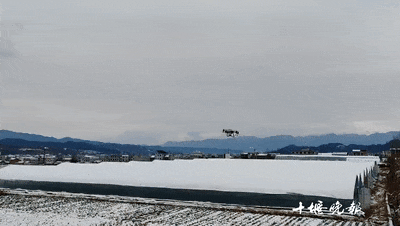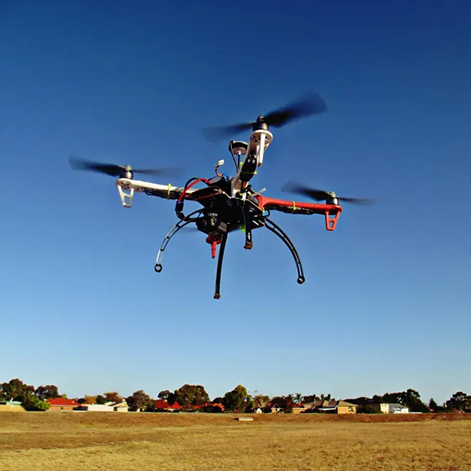Drones roam through high-rise buildings to deliver food, "air taxis" have become a new choice for travel, and agricultural drones are showing their skills in spring farming... Currently, the low altitude economy is facing multiple layouts and has become an important area for developing new driving forces. With the continuous fermentation of policies, markets, and enterprises, the scale of China's low altitude economy market will continue to grow, and the application fields will continue to expand. Industry insiders predict that by 2025, the comprehensive contribution of the low altitude economy to China's national economy will reach 3 trillion to 5 trillion yuan.
The application scenarios are constantly expanding
During the Spring Festival holiday in the the Year of the Loong, in Shenzhen Talent Park, Window of the World and many other scenic spots, the delivery drones slowly declined, and the takeout was put into the smart food collection cabinet, so that consumers could "fly" food around with their fingers.
We are conducting low altitude flight pilot tests to promote the development of unmanned aerial vehicle (UAV) end of pipe delivery services, "said Mao Yinian, the head of Meituan UAV business. The traffic carried by the road transportation network in big cities continues to grow, and there are often situations of delayed delivery during peak hours. UAV delivery uses the urban low altitude logistics network, which can effectively supplement transportation capacity and improve delivery efficiency. With policy support, Meituan drones have opened 25 routes in 11 commercial districts in cities such as Shenzhen and Shanghai, serving scenarios such as office buildings, scenic spots, and hospitals.
Moreover, agricultural drones are currently unlocking a new mode of spring plowing. Zhang Xiaonan, Senior Corporate Strategy Director of DJI, stated that the application scenarios and scale of agricultural drones are constantly expanding, including crop protection operations, crop monitoring, and farmland surveying. As of October 2023, the global cumulative sales of DJI agricultural unmanned aerial vehicles have exceeded 300000 units, and the cumulative operating area has exceeded 6 billion acres. "Demand is driving enterprises to further strengthen technology and product development.
From sightseeing to urban security, from medical rescue to emergency rescue, from agricultural and forestry crop protection to power inspection, low altitude economy has been widely applied.
What is low altitude economy? Li Xiaohua, director of the International Industry Research Office of the Institute of Industrial Economics of the Chinese Academy of Social Sciences, said that low altitude economy refers to a comprehensive economic business type that generally extends to the low altitude airspace of no more than 3000 meters at a vertical height of 1000 meters, with civil manned and unmanned aerial vehicles as the carrier and multi scene low altitude flight activities such as manned, cargo carrying and other operations as the traction, and drives the integrated development of related fields.
At present, China has formed a relatively complete low altitude economic industry chain. Taking drones as an example, according to the "Outlook for the Development of China's Drone Industry in 2024" recently released by CCID Research Institute, according to incomplete statistics, there will be over 16000 drone related enterprises in China in 2023, of which more than 12000 are in the middle stage, accounting for over 70%, including drone platforms, sensors, software, and algorithm enterprises.
Central and local governments work together to accelerate layout
In the eyes of industry insiders, the low altitude economy is an emerging industry direction for global competition and an important area for cultivating and developing new driving forces. Li Shipeng, Executive Director of the Low altitude Economy Branch of the Guangdong Hong Kong Macao Greater Bay Area Digital Economy Research Institute, believes that from an industrial perspective, the low altitude economy is a highly scalable new industrial chain; From an investment perspective, the construction of low altitude infrastructure will drive effective investment; From a standard perspective, it is beneficial for China to take the lead in creating new standards and rules in the field of low altitude economy.
Currently, active deployment is being made from the central to local levels to accelerate the development of low altitude economy. The Central Economic Work Conference to be held at the end of 2023 proposed the development of several strategic emerging industries such as biomanufacturing, commercial aerospace, and low altitude economy. At the recent local two sessions, the government work reports of Beijing, Guangdong, Anhui, Jiangsu, Shandong, Chongqing, Sichuan and other places all mentioned actively exploring the development of low altitude economy.
At the same time, from relaxing restrictions on low altitude airspace to lowering the threshold for general aviation operations, the low altitude economic environment continues to be optimized. For example, on February 1st, the "Shenzhen Special Economic Zone Low altitude Economic Industry Promotion Regulations" were officially implemented, paving the way for the "rule of law" for the "takeoff" of the low altitude economy.
The sustained favorable factors such as policies and markets will promote the rapid breakthrough of key technologies in China's low altitude economy and the continuous expansion of application fields, "said Gui Bingxiu, deputy researcher at CCID Research Institute. Taking civil drones as an example, it is expected that from 2024 to 2028, the average annual growth rate of domestic civil drones will be nearly 20%, and emerging technologies are expected to enter a period of rapid iteration.
Overall, according to the recent low altitude economy white paper released by the Guangdong Hong Kong Macao Greater Bay Area Digital Economy Research Institute, the comprehensive contribution value of low altitude economy to China's national economy will reach 3 trillion to 5 trillion yuan by 2025.
Policy measures need to be improved
However, industry insiders also indicate that China's low altitude economy is still in its infancy, and further efforts are needed to improve the policy and regulatory system, strengthen supporting measures, and expand application areas.
Gui Bingxiu believes that on the one hand, the government needs to strengthen supervision of drones, formulate corresponding laws, regulations, and rules, and continuously improve and update them to adapt to the rapid development of drone technology and the constantly changing market; On the other hand, we should actively promote the development of the drone industry, formulate corresponding industrial policies, encourage enterprises to increase research and development investment, promote innovation and application of drone technology, and promote the healthy development of the low altitude economy industry.
The development of low altitude economy needs to be combined with technological development trends, focus on deepening the layout of incremental development scenarios, and continuously expand application areas and market space. "Zhang Xiaonan said that enterprises will continue to promote the large-scale application of the drone industry in various scenarios such as film and television aerial photography, handheld imaging, agricultural crop protection, drone patrol and mapping, and transportation, and constantly expand new application areas.





